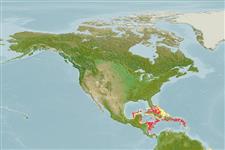التصنيف / Names
الأسماء الشائعة | مرادفات | Catalog of Fishes(جنس, الانواع) | ITIS | CoL | WoRMS | Cloffa
>
Blenniiformes (Blennies) >
Dactyloscopidae (Sand stargazers)
Etymology: Dactyloscopus: Greek, daktylos = finger + Greek, skopein = to look (Ref. 45335); comptus: comptus, adorned or ornamented, in allusion to the circlet of flaps or spots on the eye..
Environment: milieu / climate zone / depth range / distribution range
البيئة
بحري القاع. Tropical
Western Central Atlantic: all specimens from the Bahamas, except for two provisionally identified specimens from Puerto Rico and St. John, Virgin Islands. Also Ref. 26938.
الحجم / وزن / العمر
Maturity: Lm ? range ? - ? cm
Max length : 3.9 cm SL ذكر/ مختلط الجنس; (Ref. 27742)
وصف مختصر
الوصف الخارجي | قياسات المظهر الخارجي
الأشواك الظهرية (المجموع): 11 - 13; شوكة شرجية 2; أشعه شرجية لينه: 28 - 30. Common amongst Dactyloscopidae: Small, elongate fishes. Head usually broad and deep, body tapering and compressed behind. Eyes on top of head, often protrusible; mouth moderate to large, oblique to vertical; upper and/or lower lips with fimbriae; jaw teeth minute, in 2 or more series; no teeth on roof of mouth (vomer and palatines). Opercular opening large, gill membrane free from isthmus; opercles membranous, large, usually overlapping on underside of head, typically fringed above with 2 to 24 fleshy fimbriae. Dorsal fin continuous, with an isolated or semi-isolated anterior finlet, or with 1 to 5 separate anterior rays; dorsal-fin spines 7 to 23; anal-fin spines 2; dorsal and anal fins free or united to caudal fin by fragile membranes; pectoral fins broad-based, usually enlarged in mature males; caudal-fin rays simple or branched; pelvic fins under throat (insertion anterior to pectoral-fin base), with 1 spine and 3 thickened segmented rays; all other rays simple. Head and venter naked, body elsewhere with large cycloid scales (smooth to touch); lateral line high anteriorly, deflecting ventrally behind pectoral fin to continue along middle of side to caudal-fin base where terminal lateral-line scale bears ventrally directed canal. Body coloration, variably pale to strongly pigmented with white, brown, or reddish; some forms with characteristic saddle-like bars crossing back; others plain, mottled, or with indications of lateral stripes. Species distinguished by: dorsal-fin origin on nape without a distinct anterior finlet; spines usually 11 to 13. First preopercular canal branched, with 2 or more distal pores. Segmented anal-fin rays 28 to 30. Posterior naris (a single pore) located on anterior rim of preorbital, adjacent to base of tubiform anterior naris; premaxillary pedicels reach well past rear margins of orbits. Upper lip fimbriae usually 10 to 13; eye with a distal ring of translucent spots or dermal flaps. Expanded eyestalk not exceptionally long and slender (Ref. 52855).
Life cycle and mating behavior
النضج | التكاثر | وضع البيض | بيض | الخصوبة | Larvae
Dawson, C.E., 1982. Atlantic sand stargazers (Pisces: Dactyloscopidae), with description of one new genus and seven new species. Bull. Mar. Sci. 32(1):14-85. (Ref. 27742)
IUCN Red List Status (Ref. 130435)
استخدامات بشرية
مزيد من المعلومات
الأسماء الشائعةمرادفاتالأيضمفتريساتعلم السميات البيئيةالتكاثرالنضجوضع البيضتجمعات وضع البيضالخصوبةبيضتطور البيضة
العمر/ الحجمنموالطول-الوزنالطول-الطولالطول- التردداتقياسات المظهر الخارجيالوصف الخارجيLarvaeحركة انتقال اليرقاتتوظيفالوفرةBRUVS
مراجعالأستزراع المائيملف الأستزراع المائيسلالاتجينيElectrophoresesالتوريثالأمراضمعالجةNutrientsMass conversion
المتعاونينصورStamps, Coins Misc.اصواتالتسمم باكل السمكسرعةنوع السباحةمنطقة الخياشيمعظمة الأذندماغرؤية
أدوات
تقارير خاصة
Download XML
مصادر علي الأنترنت
Estimates based on models
Preferred temperature (Ref.
123201): 25.8 - 28.1, mean 27.7 °C (based on 110 cells).
Phylogenetic diversity index (Ref.
82804): PD
50 = 0.5000 [Uniqueness, from 0.5 = low to 2.0 = high].
Bayesian length-weight: a=0.00389 (0.00180 - 0.00842), b=3.12 (2.94 - 3.30), in cm total length, based on all LWR estimates for this body shape (Ref.
93245).
مستوى غذائي (Ref.
69278): 3.8 ±0.6 se; based on size and trophs of closest relatives
Fishing Vulnerability (Ref.
59153): Low vulnerability (10 of 100).
